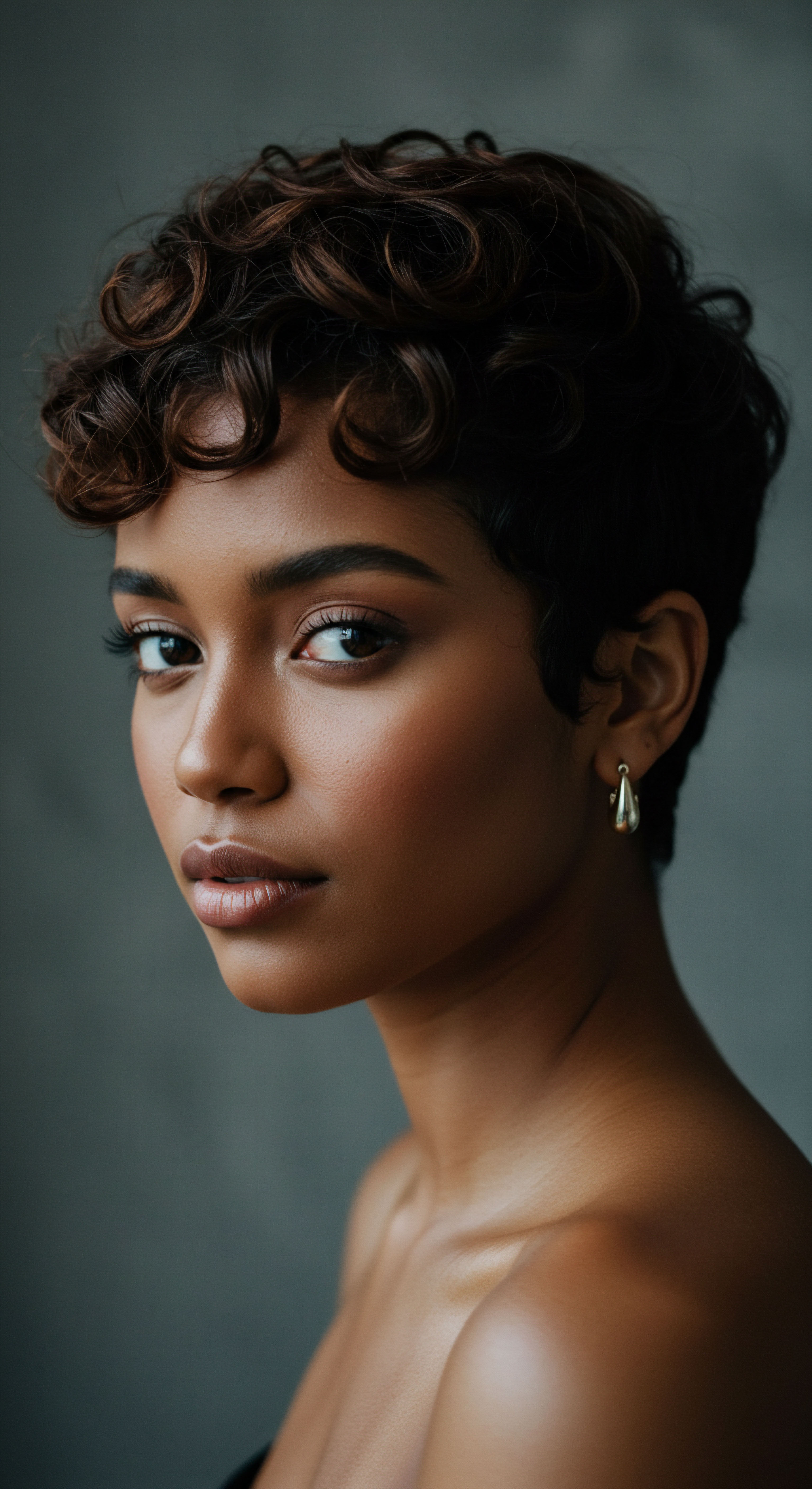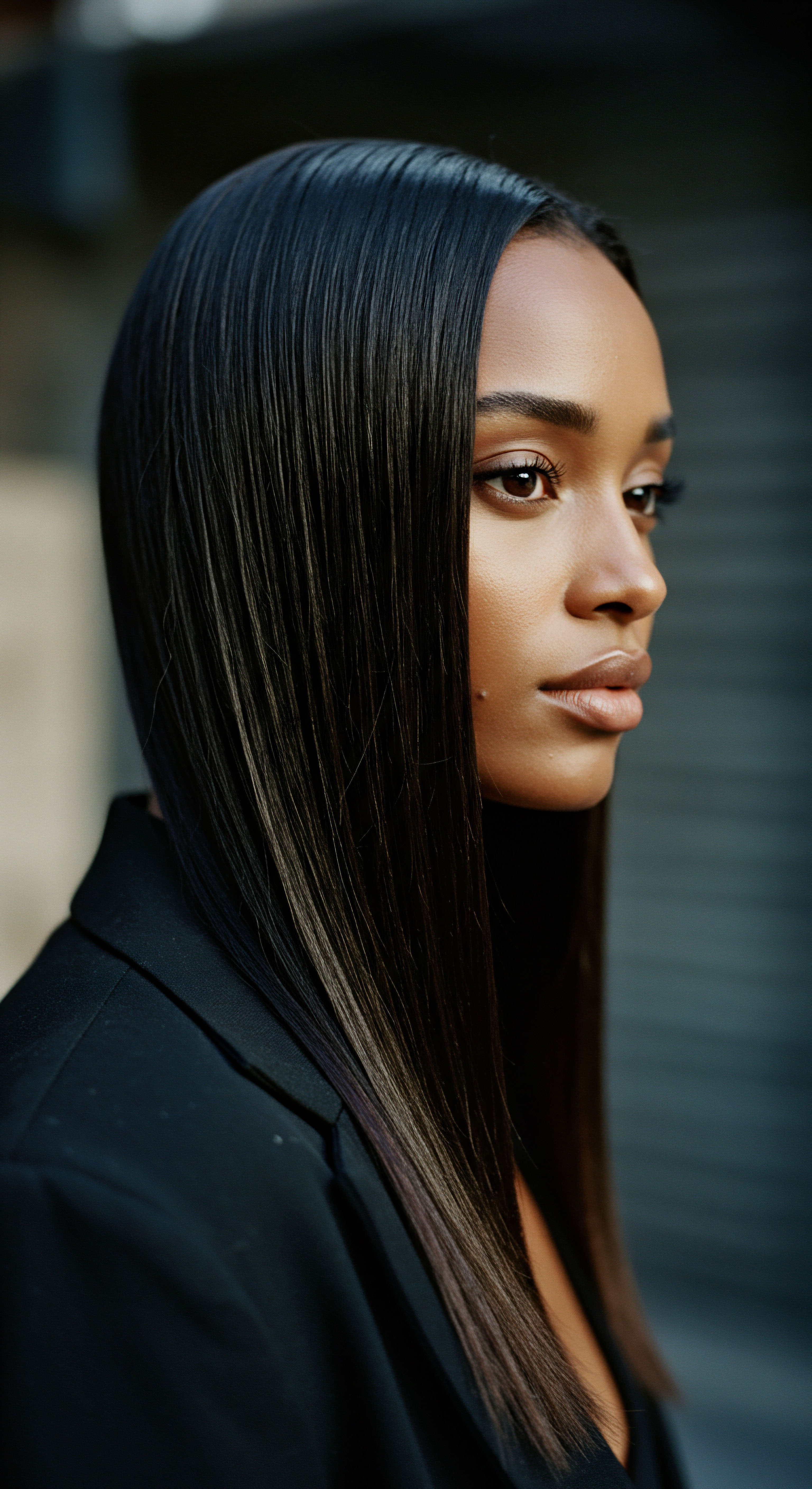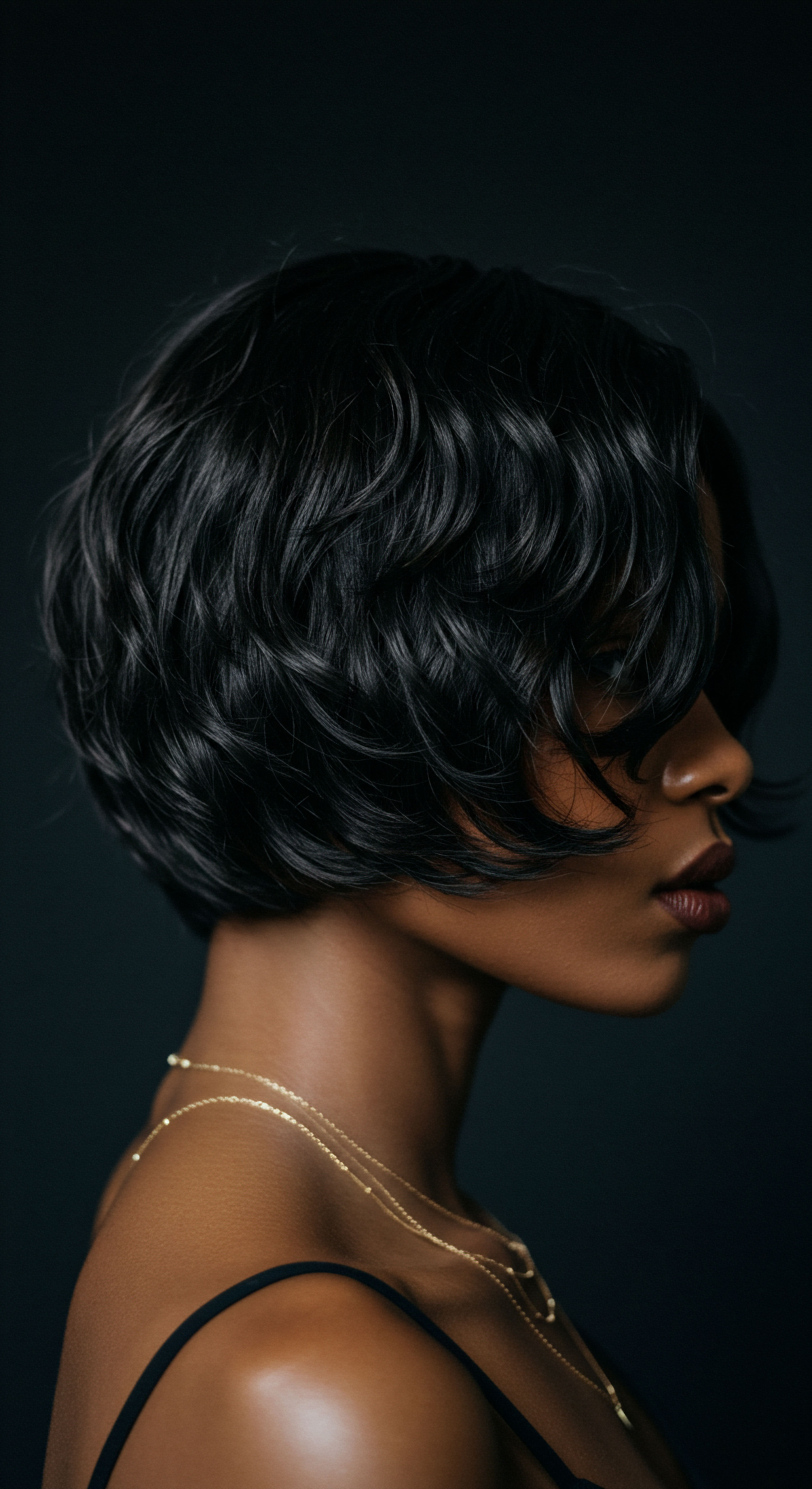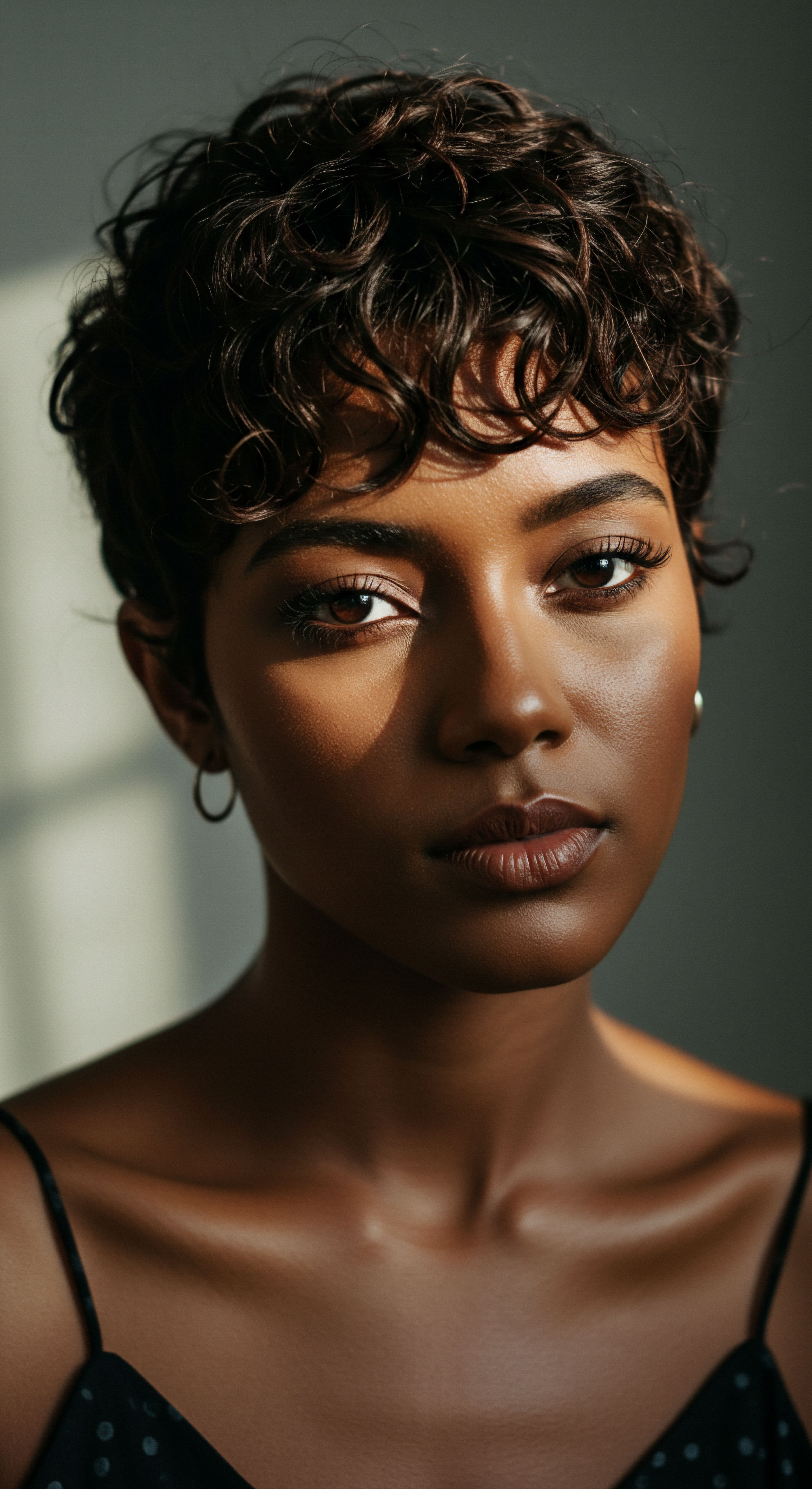
Roots
The whisper of static, a fleeting dance of errant strands, often arrives unbidden, particularly when the air feels crisp and thin. This phenomenon, familiar to many, especially those tending to textured hair, is more than a mere annoyance; it is a subtle conversation between our hair and its environment, a testament to the delicate electrical balance at play. To truly understand how certain elixirs and balms might soothe this energetic disquiet, we must first journey inward, exploring the very architecture of a single strand and the unseen forces that shape its interaction with the world. It is within this elemental understanding that the pathway to serene, settled tresses begins to unfurl.

The Hair Strand An Electrical Canvas
Each strand of hair, a marvel of biological design, is composed primarily of Keratin, a robust protein. This intricate structure possesses inherent electrical properties. At its outermost layer, the cuticle, a series of overlapping scales, serves as a protective shield. When these scales lie flat and smooth, hair reflects light with a pleasing sheen, and its surface charge tends to remain balanced.
However, in conditions of low moisture, the very air around us becomes a less hospitable medium for the dissipation of electrical charges. Friction, whether from a brush stroke, a scarf, or even the subtle movement of hair against itself, can cause electrons to transfer from one surface to another. This exchange leaves one surface with an excess of electrons (a negative charge) and the other with a deficit (a positive charge). When hair acquires a uniform charge, usually positive, individual strands repel one another, creating that familiar, ethereal halo.
Static on hair arises from an imbalance of electrical charges, often exacerbated by low environmental moisture.
Consider the triboelectric effect, a principle at the heart of static generation. This effect describes the charge separation that occurs when two different materials come into contact and then separate. Hair, a material with a specific position on the triboelectric series, will readily gain or lose electrons depending on the material it interacts with.
For instance, rubbing hair with a synthetic fabric like polyester will often result in a significant charge transfer, leaving hair positively charged and prone to repulsion. The very composition of hair, its proteinaceous nature, makes it particularly susceptible to this charge accumulation when the surrounding humidity offers no conductive escape route for these stray electrons.

When Dryness Invites Disquiet
Low moisture conditions, whether due to arid climates, indoor heating, or even excessive washing with harsh cleansers, strip the hair of its natural humectants and emollients. This dryness renders the hair shaft a less efficient conductor. Water, a polar molecule, acts as a natural conductor, allowing electrical charges to flow freely and neutralize. When the hair lacks sufficient internal and external moisture, these charges become trapped on the hair surface, unable to dissipate into the atmosphere or into other objects.
This trapped charge is the essence of static. The hair, craving equilibrium, becomes a magnet for airborne dust and particles, which can further compound the issue by contributing to the surface charge.
The delicate balance of the hair’s surface pH also plays a subtle, yet significant, role. Hair, by nature, is slightly acidic, typically ranging from pH 4.5 to 5.5. This acidity helps to keep the cuticle scales tightly closed. When hair is exposed to alkaline products or environments, the cuticle can lift, creating a rougher surface.
A rougher surface means more friction points, and more friction points can lead to greater charge separation and, consequently, more static. Maintaining the hair’s natural acidic mantle is therefore a quiet act of defiance against the unwelcome presence of static.
| Hair Component Cuticle |
| Role in Static Outermost layer; lifted scales increase friction and charge accumulation. |
| Hair Component Cortex |
| Role in Static Inner core; protein structure holds charge if moisture is low. |
| Hair Component Moisture Content |
| Role in Static Acts as a conductor; low levels hinder charge dissipation. |
| Hair Component Surface pH |
| Role in Static Altered pH can lift cuticles, increasing static potential. |
| Hair Component The integrity of the hair's outer layer and its moisture levels are central to managing static. |

Ritual
Stepping from the quiet contemplation of hair’s fundamental nature, we arrive at the threshold of daily practice, where thoughtful selections and gentle applications transform understanding into tangible comfort. The pursuit of hair serenity in low moisture conditions is less about a single miraculous cure and more about a symphony of consistent, deliberate actions. It is in the careful layering of hydration, the mindful choice of tools, and the consistent nourishment that we discover pathways to quiet the electrical hum and bring our strands into a state of graceful repose.

Quelling the Electrical Hum
The primary strategy for minimizing static lies in saturating the hair with moisture and creating a smooth, conductive surface. Products designed to achieve this often feature humectants, which draw water from the air or from within the product itself, and emollients, which coat the hair shaft, providing a lubricating barrier.
- Leave-In Conditioners are perhaps the most direct line of defense. Applied after cleansing, these formulations often contain a delicate balance of humectants, such as glycerin or hyaluronic acid, and emollients, like various plant oils or silicones. They act as a continuous veil of hydration, helping to keep the hair shaft pliable and less prone to frictional charge buildup. The lighter, milky textures often suit finer strands, while richer creams can provide substantial solace for denser, coarser textures.
- Styling Creams and Balms offer a more concentrated dose of smoothing agents. These products often possess a heavier molecular weight, providing a protective coating that not only helps to define curls and coils but also significantly reduces the opportunity for static charges to accumulate. Their richer textures help to weigh down individual strands just enough to prevent them from flying apart, creating a cohesive, settled appearance.
- Hair Oils and Serums, particularly those rich in fatty acids, serve as excellent sealants. While they do not directly hydrate, they lock in the moisture provided by other products and create a smooth, hydrophobic surface. This barrier reduces friction and prevents moisture loss from the hair shaft, thereby maintaining its conductivity and preventing charge buildup. Lighter oils, like argan or jojoba, are often preferred for their ability to provide shine without undue heaviness, while heavier options, such as castor or olive oil, offer profound sealing benefits for very dry or highly porous strands.

Which Products Offer Respite From Static?
The efficacy of a product in combating static often hinges on its antistatic properties. Many conditioners and styling products incorporate ingredients known as Cationic Surfactants, or quaternary ammonium compounds. These positively charged molecules are drawn to the negatively charged sites on damaged hair (which are more prevalent in dry conditions), effectively neutralizing the charge and reducing repulsion between strands.
Common examples include behentrimonium methosulfate, cetrimonium chloride, and stearamidopropyl dimethylamine. These ingredients not only quell static but also often provide conditioning benefits, smoothing the cuticle and making hair more manageable.
Consider the composition of the product’s base. Water, being polar, is an exceptional conductor. Products with a high water content, combined with humectants, provide an immediate surge of moisture that helps to ground electrical charges.
Emulsified formulations, where oils and water are blended, deliver both hydration and a protective film, offering a dual approach to static mitigation. The texture of the product also matters; a richer, more substantive product often provides a more lasting barrier against environmental dryness than a very light, watery mist.
Products with humectants, emollients, and cationic surfactants are effective in reducing hair static.

The Silent Contributions of Tools
Beyond the lotions and potions, the instruments we use to tend our hair play a silent, yet potent, role in the static equation. Brushes made from natural bristles, such as boar bristles, tend to generate less static than their synthetic counterparts. This is due to their material composition and their ability to distribute the hair’s natural oils more evenly, contributing to a smoother, less electrically charged surface. Similarly, combs crafted from wood or carbon fiber often exhibit superior antistatic properties compared to plastic.
Even the humble hairdryer can be a source of static. Traditional dryers, which blast hot air, can strip hair of moisture, exacerbating dryness and creating a fertile ground for static. Ionic hairdryers, by contrast, emit negatively charged ions that attach to the positively charged water molecules on the hair, breaking them down into smaller particles that can be absorbed more readily.
This process not only speeds up drying time but also helps to seal the cuticle, leading to a smoother finish with significantly less static. The choice of styling tools, therefore, becomes an extension of our conscious care ritual, quietly influencing the hair’s electrical demeanor.

Relay
Moving beyond the immediate relief of products and tools, our exploration deepens into the intricate dance between our strands, the atmosphere, and the very fibers we choose to adorn ourselves with. The persistent presence of static in low moisture conditions invites us to consider not just the superficial application of remedies, but the profound interplay of material science, environmental thresholds, and even historical adaptations. It is here, at the confluence of the tangible and the unseen, that a truly nuanced understanding of hair’s electrical disposition takes hold.

The Triboelectric Tapestry A Deeper Unraveling
While we previously touched upon the triboelectric effect, its specific manifestations with various materials warrant a closer examination. The triboelectric series ranks materials by their propensity to gain or lose electrons when rubbed against another material. Materials higher on the list tend to become positively charged, while those lower tend to become negatively charged.
Hair, typically positioned in the middle to upper-middle of this series, often acquires a positive charge when rubbed against common synthetic fabrics like nylon, polyester, or acrylic. These fabrics, being lower on the series, readily gain electrons, leaving the hair with a positive charge and thus, repulsion.
A study published in the Journal of Colloid and Interface Science in 2008 by R. K. Singh and colleagues, investigating the surface charge properties of human hair, found that the triboelectric charging of hair is significantly influenced by its surface chemistry and the relative humidity of the environment. Their research demonstrated that as relative humidity decreases, the magnitude of charge acquired by hair through friction increases substantially, underscoring the critical role of moisture in mitigating static.
This empirical observation reinforces the notion that static is not merely a product deficiency but a fundamental physical interaction amplified by atmospheric conditions. The study also hinted at how specific chemical treatments or modifications to the hair surface could alter its position on the triboelectric series, thereby influencing its propensity for charge accumulation.

Can Water Quality Influence Hair’s Electrical Tendencies?
The very water we use to cleanse our hair, often overlooked in the static discussion, can subtly contribute to its electrical behavior. Hard water, rich in dissolved minerals like calcium and magnesium, can leave behind a microscopic film on the hair shaft. This mineral buildup can create a rougher surface, increasing friction points and potentially hindering the smooth dissipation of electrical charges.
While not a direct cause of static, this mineral residue can certainly exacerbate the problem by compromising the hair’s natural smoothness and its ability to absorb and retain moisture effectively. A chelation shampoo, used periodically, can help to remove these mineral deposits, restoring the hair’s surface integrity and improving its responsiveness to moisturizing agents.
Beyond mineral content, the pH of the water also plays a part. Water that is too alkaline can cause the hair cuticle to swell and lift, making the hair more porous and more susceptible to moisture loss. As discussed earlier, compromised cuticle integrity means increased friction and a greater likelihood of charge accumulation. Therefore, a gentle, pH-balanced cleansing routine, potentially utilizing a mild acidic rinse, can support the hair’s natural barrier function and contribute to a more electrically stable surface.

The Quiet Resilience of Cultural Practices
Across diverse cultures, long before the advent of modern cosmetic chemistry, communities developed ingenious methods to preserve hair’s vitality and manage its texture, often inadvertently addressing issues like static. The practice of Hair Oiling, deeply rooted in many African, Asian, and indigenous traditions, serves as a powerful testament to intuitive wisdom. Oils like coconut, argan, or shea butter, applied regularly, create a protective lipid layer around the hair shaft.
This layer not only seals in internal moisture but also acts as a natural antistatic barrier, reducing friction and preventing the hair from acquiring a positive charge from the environment. These practices, often passed down through generations, speak to a profound understanding of hair’s needs in varying climates, providing a tangible link between ancestral knowledge and contemporary hair science.
Similarly, the tradition of Hair Wrapping or covering, seen in various forms from headwraps to bonnets, offers both aesthetic and protective benefits. Beyond preserving intricate styles, these coverings, particularly those made from smooth, natural fibers like silk or satin, minimize friction between hair and external surfaces. Unlike rougher materials such as cotton, which can strip moisture and generate static, silk and satin allow hair to glide, significantly reducing charge transfer and maintaining a smoother cuticle. This age-old practice is a sophisticated form of static prevention, born from a deep appreciation for hair’s vulnerability to environmental stressors.
| Material Type Synthetic Fabrics (Nylon, Polyester) |
| Impact on Hair Static High propensity to generate static due to triboelectric properties. |
| Material Type Natural Bristle Brushes (Boar) |
| Impact on Hair Static Low static generation; distributes natural oils. |
| Material Type Silk/Satin (Pillowcases, Wraps) |
| Impact on Hair Static Minimizes friction, reducing static transfer. |
| Material Type Hard Water Minerals |
| Impact on Hair Static Can create rough surface, exacerbating static. |
| Material Type The materials that touch our hair significantly influence its electrical behavior. |

Reflection
The quiet hum of static, once a perplexing annoyance, now reveals itself as a symphony of physical interactions, a delicate dance of electrons and environmental whispers. Our journey through the fundamental nature of hair, the conscious rituals of care, and the deeper cultural and scientific relays has brought us to a more profound appreciation for the resilience of our strands. There is a gentle strength in understanding that the quest for serene hair is not merely about suppressing a symptom, but about nurturing an intricate balance, respecting its inherent electrical nature, and honoring the wisdom passed down through generations. Each conscious choice, from the humectant-rich balm to the smooth satin pillowcase, contributes to a harmonious existence with our hair, allowing it to rest, to flourish, and to truly settle into its own quiet splendor, even when the air is dry.

References
- Singh, R. K. Gupta, V. & Misra, A. (2008). Surface charge properties of human hair and its triboelectric charging. Journal of Colloid and Interface Science, 321(1), 160-166.
- Robbins, C. R. (2012). Chemical and Physical Behavior of Human Hair (5th ed.). Springer.
- Goeckeler, S. (2009). Hair Care ❉ Chemistry and Formulations. Allured Publishing Corporation.
- Schueller, R. & Romanowski, P. (2006). Conditioning Agents for Hair and Skin. CRC Press.
- Wilkerson, M. (2017). The Science of Black Hair ❉ A Comprehensive Guide to Textured Hair Care. CreateSpace Independent Publishing Platform.
- Marsh, J. (2014). Hair ❉ A Cultural History. Faber & Faber.
- Dawber, R. P. R. & Van Neste, D. (2002). Hair and Scalp Disorders ❉ Clinical and Experimental Dermatology. Blackwell Science.
- Hunter, L. (2006). The Science of Hairdressing. Thomson Delmar Learning.